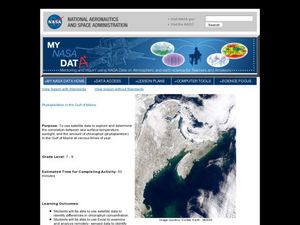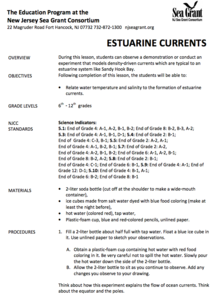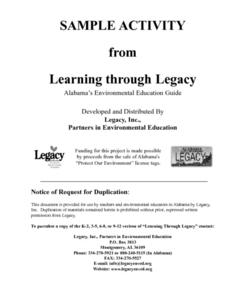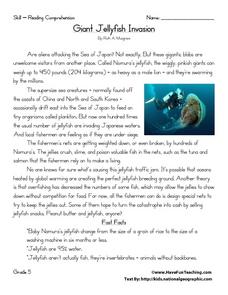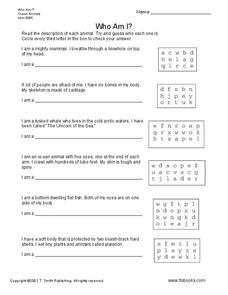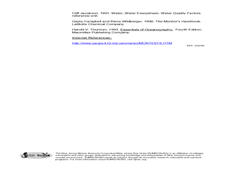Curated OER
Phytoplankton in the Gulf of Maine
Students use satellite data to see the correlation between sea temperature and sunlight in the Gulf of Maine. In this phytoplankton activity students use Excel to analyze data.
California Academy of Science
Buoyancy Bulls-Eye
Why does a seastar sink, but a jellyfish float? Through a fun investigation, learners examine the concept of buoyancy using simple household items. The challenge: create neutral buoyancy for an action figure in water. With ample...
Polar Trec
Nature's Density Column
Nature provides density columns in the polar regions that provides food for many animals. Young scientists build their own density columns with water in order to answer analysis questions. Through a slideshow presentation, scholars...
Curated OER
BIoluminescence
High schoolers investigate the concept of bioluminescence. They use dinoflagellates in a lab situation to study photosynthesis. They conduct research into the concept using a variety of resources. Also the class is taken on a field trip...
Curated OER
Food Chains and Food Webs
Fourth graders study intertidal organisms and their role in the food web. In this food web lesson, 4th graders read the book The Sea That Feeds Us and discuss food webs. Students study pictures of intertidal creatures and discuss their...
Curated OER
Estuarine Currents
Students experiment observing a demonstration on models of density-driven currents which are typically found in an estuarine system of water flow. They compare/contrast water temperature and salinity to the formations of estuarine currents.
Curated OER
What is Coral?
Students discuss what they know about coral reefs and are introduced to the importance of preserving coral reefs. In this coral reef lesson, students make connections between coral ecology in the classroom and in the real environment...
Curated OER
Gotta Have Energy
Students explore energy. They discuss the types and uses of energy and research an assigned energy source. They create a "benefits versus potential environmental impacts" chart that lists energy sources and possible impacts. They...
Curated OER
Biomes
In this biomes instructional activity, students review the characteristics of aquatic biomes and terrestrial biomes. This instructional activity has 12 fill in the blank, 6 multiple choice, and 4 short answer questions.
Curated OER
Sharks Taxonomy
Students, in groups, establish a classification system for the world of your classroom. They draw a chart to explain their categories and system to the rest of the class.
Curated OER
Giant Jellyfish Invasion
In this reading comprehension skills activity, students read a 1 page selection entitled "Giant Jellyfish Invasion" and then respond to 5 multiple choice questions.
Curated OER
Ocean Vocabulary
In this vocabulary learning exercise, students match words related to the ocean to their definitions. Worksheet is labeled as a quiz, but may be used as review/practice.
Curated OER
Who Am I?
In this earth science worksheet, students read the description of each animal and identify who each one is. They circle every third letter in the box to the right to check their answer.
Curated OER
Invertebrates
In this invertebrates activity, high schoolers read about the characteristics of the different groups of invertebrates. Then students complete 10 multiple choice questions.
Curated OER
Save the Bay
Students explore the concept of environmental stewardship. In this science lesson, students examine the environmental effects of oil spills as they replicate a contained oil spill and clean up.
Curated OER
Baleen Whales vs. Toothed Whales
Second graders review mammal characteristics and study two types of whales. In this mammal study lesson, 2nd graders discuss mammals and define their five characteristics. Students complete a whale worksheet and define differences...
Curated OER
The Giant Barrel Sponge
Students study barrel sponges. In this science and art lesson, students discuss what sponges are, create their own sponge, and share what they created with the rest of the class.
Curated OER
Water Quality Monitoring
Students comprehend the four parameters of water quality. They perform tests for salinity, dissolved oxygen, pH and clarity or turbidity. Students comprehend why scientists and environmental managers monitor water uality and aquatic...
Curated OER
Estuarine Currents
Pupils explore an estuarine system to gather data on density driven currents. This type of current is contrasted with temperature and wind driven currents.
Curated OER
Just Jelly
Students identify common gelatinous zooplankton in the Canada Basin and their ecological role. They compare and contrast feeding strategies of at least three different types of gelatinous zooplankton.
Other
The Marine Science Institute
The Marine Science Institute offers various general information about the San Francisco bay and its ecology.
CK-12 Foundation
Ck 12: Episd: Aquatic Organisms
[Free Registration/Login may be required to access all resource tools.] Study the research of aquatic organisms and how they move and live. Be prepared to give examples of the types of these wet organisms.
CK-12 Foundation
Ck 12: Earth Science: Types of Marine Organisms Study Guide
[Free Registration/Login may be required to access all resource tools.] This study guide summarizes key points about the types of organisms found in marine environments. Includes a few questions to check for understanding.
Other
Rutgers: c.o.o.l. Class: Physics Project: Plankton and Ocean Current
This c.o.o.l. Project focuses on tiny sea plankton and how they move in the oceans. Follow the scientific process outlined on the left, calculate and collect data to form your own predictions.
